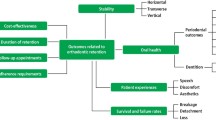Abstract
Data sources
PubMed, Medline, Embase, Cochrane Central Register of Controlled Trials, Web of Science, LILACS and Google Scholar.
Study selection
Randomised controlled trials(RCTs) that assessed functional appliance therapy in Class II malocclusions were included where they; analysed treatment effects not confounded by additional and concomitant treatments (headgear, extractions or fixed appliances); used cephalometric analysis at the start of treatment and just after removal of the functional appliances; and measured mandibular anteroposterior changes using the anatomic condylion. No language restrictions were applied.
Data extraction and synthesis
The selection process was conducted by two independent reviewers. The data were synthesised using a random-effects model with heterogeneity being assessed using the Cochrane test and the I2 statistic. A sensitivity analysis was conducted.
Results
Four trials were finally included involving 338 patients (168 treated vs 170 controls). Three of the four were assessed as having medium-high level statistical methods. The results of the meta-analysis from the random-effects model showed a statistically significant difference of 1.79 mm in annual mandibular growth of the treatment group compared with the control group (SMD 5 0.61, 95% CI, 0.30 to −0.93; chi-square test, 5.34; 3 df; P 5 0.15; I2 5 43.9%; test for overall effect, Z 5 3.83 and P 5 0.0001). The sensitivity analysis showed a substantially similar outcome of 1.91 mm (SMD 5 0.65, 95% CI, 0.25 to 1.25; chi-square test, 4.96; 2 df; P 5 0.08; I2 5 59.7%; test for overall effect, Z 5 3.19 and P 5 0.001).
Conclusions
The analysis of the effect of treatment with functional appliances compared with an untreated control group showed that skeletal changes were statistically significant but unlikely to be clinically significant.
Similar content being viewed by others
Commentary
One significant critique to this systematic review is the question they asked. The reader may challenge the authors by asking why is it important to know how much mandibular growth is attained short-term. A lot of the so called functional appliances are used as a phase I orthodontic treatment that will eventually be followed by full bonded brackets and archwires. In other words there is still going to be 18 to 24 months of orthodontic treatment that may negate or improve mandibular growth. Should the question really not be how much mandibular growth will still be present after all orthodontic treatment has been completed and the individual has finished the most significant part of its facial growth and development?
From the patient's point of view do they really care about an increase of 2 or 3 mm? Can they actually conceptualise such a change? For them at the end is a question of chin projection and facial profile. That is actually the question to be asked. This would align itself with the current outcome paradigm change to patient driven results.
This systematic review does not have any glaring problems. It is not perfect because nothing we can produce in science can be perfect. Limitations that were identified for the systematic review methods itself are specifically related to better reporting. Regarding the included articles themselves, as is common in dental research, significant risk of bias was recognised for all the included studies. Small sample sizes, heterogeneity between studies and differences in interventions and outcomes clearly come up.
In summary, the results from this systematic review, when considered alone, are of nil clinical importance. The question itself was of a narrow scope. Having said that, if these results are properly framed by considering all the factors involved in clinical decisions for the treatment of class II malocclusion of mandibular origin, the findings do offer a nice summary of short-term mandibular changes during early functional treatment.
Author information
Authors and Affiliations
Additional information
Address for correspondence: Elvira Marsico, Vle Boccetta, 14, 98122 Messina, Italy. E-mail: elvira.marsico@alice.it
Marsico E, Gatto E, Burrascano M, Matarese G, Cordasco G. Effectiveness of orthodontic treatment with functional appliances on mandibular growth in the short term. Am J Orthod Dentofacial Orthop 2011; 139: 24–36.
Rights and permissions
About this article
Cite this article
Flores-Mir, C. Limited evidence of a small effect on mandibular growth using functional appliances. Evid Based Dent 13, 23 (2012). https://doi.org/10.1038/sj.ebd.6400845
Published:
Issue Date:
DOI: https://doi.org/10.1038/sj.ebd.6400845



